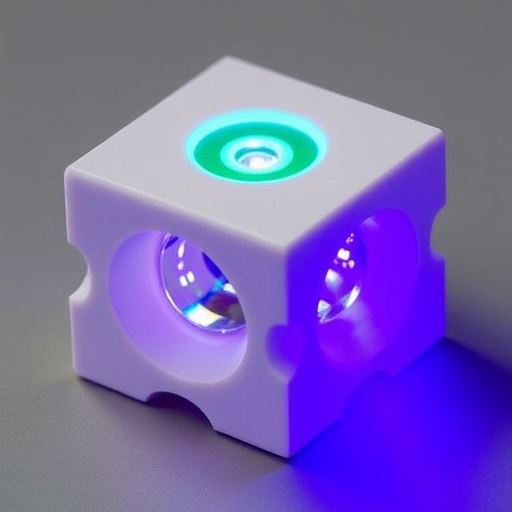In an unprecedented breakthrough in photonics and biomedical imaging, a team of researchers led by Gu, S., Lian, H., and Kuang, R. has unveiled a revolutionary laser-driven luminescent ceramic-converted near-infrared II (NIR-II) light source, marking a significant leap forward in advanced imaging and detection methodologies. Published recently in Light: Science & Applications, this novel light source promises to transform the landscape of medical diagnostics, materials analysis, and security screening by providing unparalleled resolution and penetration depth compared to current technologies.
The development hinges on the strategic use of laser-driven luminescent ceramics, a composite material engineered to convert high-energy laser light into highly efficient and broad-spectrum NIR-II emissions. The NIR-II window, spanning wavelengths roughly between 1000 and 1700 nanometers, is particularly prized in imaging sciences due to its reduced scattering and autofluorescence effects in biological tissues. This translates to clearer images at greater depths, surpassing the limitations inherent in traditional visible and early near-infrared imaging techniques.
At the core of this innovation is a refined ceramic material doped with rare-earth ions, meticulously fabricated to optimize luminescent efficiency and thermal stability under intense laser excitation. The ceramics are designed to operate reliably under continuous laser pumping, maintaining consistent emission without degradation, a problem that has plagued many previous solid-state luminescent sources. Such stability opens the door for prolonged imaging sessions crucial in clinical and industrial applications.
The research team employed advanced material synthesis techniques to embed these luminescent centers into a ceramic matrix, leveraging the inherently robust mechanical properties of ceramics alongside the enhanced optical characteristics bestowed by rare-earth doping. This synergy results in a light source that is both resilient and highly performant, making it adaptable to various environmental conditions and operational demands, including portable and field-deployable systems.
From an optical engineering perspective, this laser-driven ceramic system addresses the often contradictory demands of high brightness, narrow spectral bandwidth, and spatial coherence required for advanced imaging. By harnessing the controlled excitation of the ceramic matrix, the source emits a nearly monochromatic NIR-II beam with exceptional intensity. This feature is crucial for techniques like fluorescence imaging, optical coherence tomography, and photoacoustic sensing, which rely on precise light-matter interactions.
One of the noteworthy aspects of this work is the engineering finesse in managing thermal loads within the ceramic converter. High-powered lasers induce substantial heat, risking material deformation and emission instability. The team’s approach to thermal dissipation involves not only the ceramic’s intrinsic thermal conductivity but also innovative cooling designs integrated within the experimental setup. As a result, the luminescent source operates efficiently while minimizing signal noise that could undermine imaging quality.
The implications for biomedical imaging are profound. With enhanced penetration capabilities into human tissues and reduced phototoxicity compared to visible light, this NIR-II light source paves the way for safer, deeper, and more detailed visualization of internal structures. This advancement holds particular promise for early cancer detection, vascular imaging, and brain mapping, where current modalities face limitations in resolution or invasiveness.
Beyond healthcare, the laser-driven luminescent ceramic source bears significant potential in environmental monitoring and industrial inspection. The deep-penetrative NIR-II emissions can be used to detect hidden defects in composite materials or uncover contaminants within complex matrices, enabling more accurate quality control and safety assessments. Security applications, such as concealed weapon detection or biometric scanning, could also benefit from the system’s high resolution and rapid response times.
The researchers demonstrated the practical utility of their innovation through a series of proof-of-concept imaging experiments, employing both biological phantoms and engineered test samples. The resultant images showcased remarkable clarity and contrast enhancement when compared to conventional NIR imaging sources, affirming the effectiveness of the luminescent ceramic converter system in real-world scenarios.
Moreover, this technology holds scalable manufacturing potential. Since ceramics are compatible with established industrial fabrication methods, it is feasible to produce these luminescent sources in large quantities at competitive costs. This scalability ensures that the innovation can transcend research laboratories, finding its place in commercial imaging devices and diagnostic equipment worldwide.
The marriage of photonic engineering and materials science exhibited in this work exemplifies a growing trend toward multifunctional, adaptive light sources that meet the nuanced demands of modern imaging. By pushing the wavelength boundaries and enhancing output quality, the team has effectively opened a new frontier in non-invasive diagnostics and advanced sensing technologies.
Future research directions suggested by the authors include optimizing the spectral tunability of the ceramic converters to customize emissions for specific imaging tasks, as well as integrating these sources with next-generation detectors and computational imaging frameworks. Such integrations could further magnify resolution capabilities and enable real-time, high-throughput diagnostics.
Additionally, the inherent robustness and stability of the laser-driven ceramic light source make it a promising candidate for space exploration and remote sensing applications, where equipment must endure harsh environments while providing reliable data. The team’s foundational work could catalyze the development of miniaturized NIR-II spectroscopic tools for planetary analysis or atmospheric studies.
This cutting-edge innovation underscores the synergy that emerges when multidisciplinary expertise converges: material scientists, optical engineers, and biomedical researchers working collectively to dissolve longstanding technical barriers. The laser-driven luminescent ceramic-converted NIR-II light source stands as a testament to how targeted material design can revolutionize the functionality and accessibility of advanced photonic systems.
As the medical and scientific communities worldwide eagerly anticipate the commercialization and deeper integration of this technology, its ripple effects are expected to extend far beyond the laboratory. By fundamentally enhancing the clarity, depth, and safety of optical imaging, this research heralds a new era where invisible wavelengths become the key to seeing the unseen with unprecedented precision.
Article References:
Gu, S., Lian, H., Kuang, R. et al. Laser-driven luminescent ceramic-converted near-infrared II light source for advanced imaging and detection techniques. Light Sci Appl 14, 317 (2025). https://doi.org/10.1038/s41377-025-01953-4
DOI: https://doi.org/10.1038/s41377-025-01953-4
Tags: advanced medical diagnosticsbreakthrough in imaging methodologiescontinuous laser pumping efficiencyhigh-resolution imaging techniquesimproved imaging penetration depthlaser-driven luminescent ceramicsnear-infrared light sourcesNIR-II imaging technologyphotonics in biomedical applicationsrare-earth ion doped materialsreduced scattering in biological tissuessecurity screening advancements





